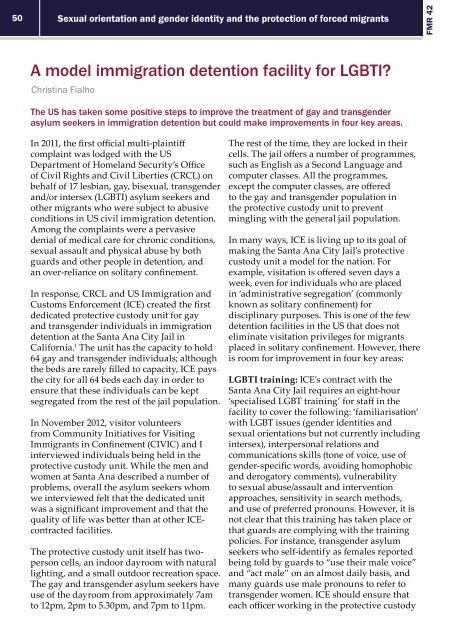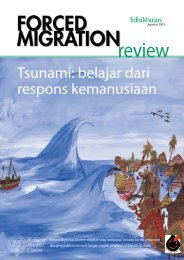FMR 42 full issue pdf - Forced Migration Review
FMR 42 full issue pdf - Forced Migration Review
FMR 42 full issue pdf - Forced Migration Review
You also want an ePaper? Increase the reach of your titles
YUMPU automatically turns print PDFs into web optimized ePapers that Google loves.
50 Sexual orientation and gender identity and the protection of forced migrants<br />
<strong>FMR</strong> <strong>42</strong><br />
A model immigration detention facility for LGBTI?<br />
Christina Fialho<br />
The US has taken some positive steps to improve the treatment of gay and transgender<br />
asylum seekers in immigration detention but could make improvements in four key areas.<br />
In 2011, the first official multi-plaintiff<br />
complaint was lodged with the US<br />
Department of Homeland Security’s Office<br />
of Civil Rights and Civil Liberties (CRCL) on<br />
behalf of 17 lesbian, gay, bisexual, transgender<br />
and/or intersex (LGBTI) asylum seekers and<br />
other migrants who were subject to abusive<br />
conditions in US civil immigration detention.<br />
Among the complaints were a pervasive<br />
denial of medical care for chronic conditions,<br />
sexual assault and physical abuse by both<br />
guards and other people in detention, and<br />
an over-reliance on solitary confinement.<br />
In response, CRCL and US Immigration and<br />
Customs Enforcement (ICE) created the first<br />
dedicated protective custody unit for gay<br />
and transgender individuals in immigration<br />
detention at the Santa Ana City Jail in<br />
California. 1 The unit has the capacity to hold<br />
64 gay and transgender individuals; although<br />
the beds are rarely filled to capacity, ICE pays<br />
the city for all 64 beds each day in order to<br />
ensure that these individuals can be kept<br />
segregated from the rest of the jail population.<br />
In November 2012, visitor volunteers<br />
from Community Initiatives for Visiting<br />
Immigrants in Confinement (CIVIC) and I<br />
interviewed individuals being held in the<br />
protective custody unit. While the men and<br />
women at Santa Ana described a number of<br />
problems, overall the asylum seekers whom<br />
we interviewed felt that the dedicated unit<br />
was a significant improvement and that the<br />
quality of life was better than at other ICEcontracted<br />
facilities.<br />
The protective custody unit itself has twoperson<br />
cells, an indoor dayroom with natural<br />
lighting, and a small outdoor recreation space.<br />
The gay and transgender asylum seekers have<br />
use of the dayroom from approximately 7am<br />
to 12pm, 2pm to 5.30pm, and 7pm to 11pm.<br />
The rest of the time, they are locked in their<br />
cells. The jail offers a number of programmes,<br />
such as English as a Second Language and<br />
computer classes. All the programmes,<br />
except the computer classes, are offered<br />
to the gay and transgender population in<br />
the protective custody unit to prevent<br />
mingling with the general jail population.<br />
In many ways, ICE is living up to its goal of<br />
making the Santa Ana City Jail’s protective<br />
custody unit a model for the nation. For<br />
example, visitation is offered seven days a<br />
week, even for individuals who are placed<br />
in ‘administrative segregation’ (commonly<br />
known as solitary confinement) for<br />
disciplinary purposes. This is one of the few<br />
detention facilities in the US that does not<br />
eliminate visitation privileges for migrants<br />
placed in solitary confinement. However, there<br />
is room for improvement in four key areas:<br />
LGBTI training: ICE’s contract with the<br />
Santa Ana City Jail requires an eight-hour<br />
‘specialised LGBT training’ for staff in the<br />
facility to cover the following: ‘familiarisation’<br />
with LGBT <strong>issue</strong>s (gender identities and<br />
sexual orientations but not currently including<br />
intersex), interpersonal relations and<br />
communications skills (tone of voice, use of<br />
gender-specific words, avoiding homophobic<br />
and derogatory comments), vulnerability<br />
to sexual abuse/assault and intervention<br />
approaches, sensitivity in search methods,<br />
and use of preferred pronouns. However, it is<br />
not clear that this training has taken place or<br />
that guards are complying with the training<br />
policies. For instance, transgender asylum<br />
seekers who self-identify as females reported<br />
being told by guards to “use their male voice”<br />
and “act male” on an almost daily basis, and<br />
many guards use male pronouns to refer to<br />
transgender women. ICE should ensure that<br />
each officer working in the protective custody




